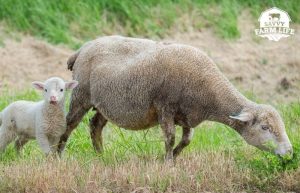
How Can You Tell If a Sheep is Pregnant?
Breeding and raising sheep is just one way your flock can produce income for you. When I was first introduced to breeding sheep, I was always wondering how to tell whether the ewe sheep was pregnant or not. In this article, I’ll share with you some easy ways to determine whether a sheep is pregnant.
How can you tell if a sheep is pregnant? The sheep’s gestation period lasts for an average of 147 days. There are several signs that you can watch for to determine whether your ewe is pregnant well before the time of birth. These signs include charting your ewe’s estrus cycle, the reflexological method, and palpation. You can also request assistance verifying pregnancy from a vet using the probing method, ultrasound, or laboratory tests.
If you have a big flock of sheep to check for pregnancy, it can be expensive to have a vet come out and check each sheep individually. I will walk you step-by-step through alternative methods to see whether your sheep is pregnant. Keep reading!
Using The Calendar To Check For Pregnancy in Sheep
If you are charting your ewe’s estrous cycle and mating encounters, you will be able to use the calendar to watch for pregnancy as well. Because the estrous cycle in sheep is 17 days long, you will not have to wait very long.
Before The Pregnancy: Understanding The Estrous Cycle in Sheep
If you are using the calendar method to gauge whether your ewe is pregnant, you will need to first understand the estrous cycle. Most breeds of sheep are fertile throughout the year, with the average estrous cycle lasting 17 days. Within these 17 days, ewes will be in heat (fertile) for approximately 24 – 36 hours. Sheep are often called “short-day breeders”, meaning that they tend to reproduce more often when the days become shorter and the daylight decreases.
There are a few subtle signs you can watch out for to indicate when your ewe is in heat. While ewes in heat do not typically seek out rams, they will be receptive to them and even swish their tails back and forth when a ram is around. The ram can smell the pheromones that she is putting off, and will seek her out. She may also bleat or urinate more frequently than normal while in heat, and there may be swelling in the reproductive area.
If your ewe was mated but did not fall pregnant, she will go into heat again in another 17 days. Because you now know the signs that indicate your ewe is in heat, you may be able to tell if your ewe is pregnant if she does not go into heat within the 17 days after mating. This is one of the earliest methods to determine if your ewe is pregnant.
To learn more about female sheep, check out my article What A Female Sheep Is Called & Interesting Female Sheep Facts.
Using The Reflexological Method To Check For Pregnancy
Not sure if your ewe has gone into heat within 17 days of mating? Or perhaps you have been watching and you don’t believe she has gone into heat, but you would like additional confirmation. One of the earliest and most accurate methods used to check for pregnancy is the reflexological method. To use this test, bring a ram into your ewe pen. The ram is an effective and natural “pregnancy test” and will be able to differentiate between the ewes by ignoring the pregnant ones and showing interest in the non-pregnant ones. If you suspect your ewe is pregnant and your ram is ignoring her, chances are you’ve got a pregnant ewe.
Palpating Your Sheep To Check For Pregnancy
You may choose to check for pregnancy, or confirm your earlier suspicions of pregnancy, by palpating your ewe’s belly. If you would like to use this method, do your best to ensure that she has not eaten in the previous 12 hours – this will help you distinguish between a lamb and a big breakfast.
Stand behind your ewe and put your hands on either side of her belly. One side of her belly will likely be larger than the other if pregnant – usually the right side. Gently press your hands into her abdomen – her belly will feel tight and hard if pregnant, instead of the softer feel of an unbred female. At this stage, you should also be able to feel the outline of the lamb (or lambs) with this method, if you know what you are feeling for. This method may seem confusing at first, but with practice and several ewes you will get better at picking out the pregnant females as opposed to the unbred ones.
Asking Your Vet To Check For Pregnancy
 If you have used the methods described above to check for pregnancy yourself and are still unsure, you may decide to ask your vet to check your ewe. There are a number of tests your vet may perform to determine whether she is pregnant including a blood test, a urine test, or an ultrasound. An ultrasound will not only confirm pregnancy in your ewe, but will also be able to tell you approximately how far along she is and how many lambs she is pregnant with. This is one advantage to using ultrasound – how exciting it is to find out how many lambs you can expect! This also helps during delivery so you know how many to expect and when there may be a problem that needs to be addressed.
If you have used the methods described above to check for pregnancy yourself and are still unsure, you may decide to ask your vet to check your ewe. There are a number of tests your vet may perform to determine whether she is pregnant including a blood test, a urine test, or an ultrasound. An ultrasound will not only confirm pregnancy in your ewe, but will also be able to tell you approximately how far along she is and how many lambs she is pregnant with. This is one advantage to using ultrasound – how exciting it is to find out how many lambs you can expect! This also helps during delivery so you know how many to expect and when there may be a problem that needs to be addressed.
Did you know that sheep can have multiple babies at a time? To learn more about baby sheep, visit my article Baby Sheep: What A Baby Sheep is Called & Other Fun Facts.
The Probing Method To Check For Pregnancy
Aside from laboratory tests and ultrasounds, your vet may also (or instead) choose to use the probing method to check for pregnancy. Pregnancy can be confirmed with the probing method only after the 75th day of pregnancy, or around the 2.5 month mark. To perform this method, the vet will use a finger to probe the ewe and feel for her uterine arteries. If the ewe is pregnant, there will be a noticeable vibration in her uterine arteries. Only a trained vet will be able to feel this vibration, so this is one method you probably do not want to try on your own.
Additional Signs Of Pregnancy In Your Sheep
There are also some symptoms that your ewe may display if she is pregnant that you can be on the lookout for.
Physical Changes in Sheep
Visually, you will likely be able to see your pregnant ewe’s abdomen take on a lopsided shape. You may see evidence of this at around 3 months of gestation, around the same time you should be able to palpate your ewe’s abdomen. You can also watch for any changes in her udder. A pregnant sheep’s udder will take on a swollen appearance and will become more rounded.
Behavioral Changes in Sheep
Due to the hormonal changes experienced during pregnancy, you may notice changes to your ewe’s behavior. She may isolate herself from others, become more assertive, or even calmer. You may also notice changes to her appetite – she may eat more or eat less than she usually does.
Milk Production in Sheep
A pregnant sheep will start producing milk as she prepares for the baby. Check the udders to see if they are swollen or have filled with milk. While this may happen further on in the pregnancy, it is one clear indication that your sheep is about to give birth.
Keeping Sheep Records
If you are encouraging pregnancy within your flock, you may be timing your ram’s encounter with your ewe based on where she is in her estrous cycle. The most successful breeders keep thorough records of their ewes, the ewes’ estrous cycles, and when they were mated. These records will serve you well as you watch for signs of pregnancy.
Your Sheep Is Pregnant – Now What?
Once you have confirmed that your ewe is pregnant, you will want to think about upping her nutrition, possibly with supplements or grain, and you should try to avoid stressful situations for her. So long as healthy ewes are receiving adequate nutrition there is little else to be done until lambing approaches.
As you want to avoid inducing stress in the ewe, it is a good idea to try and time the “seasonal” or bi-monthly chores to occur before mating. These tasks might include de-worming, administering vaccines, and trimming feet. This will help the ewe remain relaxed during her pregnancy.
Your sheep will instinctively know what is best for her body during this time. You may see her eat more, or eat less. You may see her isolate herself from the flock, or she may even gain energy. Hormonal changes will present differently in each ewe, so you can trust her to know what she needs. Of course, if you notice any changes in behavior that are concerning such as lethargy or dehydration, you should reach out to a vet.
Do All Pregnant Sheep Present Similarly?
Every sheep is an individual, and just as there are variations in every human pregnancy, so there are in every sheep pregnancy. You may notice all of the above symptoms of pregnancy in your ewe, or you may only notice one or two of these signs. The age of the ewe also comes into play when it comes to signs of pregnancy. Older, more experienced ewes often show more signs of pregnancy than younger ewes. Older ewes may also have a longer period of gestation than younger ewes.
You, too, will become more experienced as you continue to breed your sheep. While this may all seem confusing as someone preparing for their first breeding season, after a few lambs it will become easier and less stressful to you.
Did you there that there are over 47 sheep breeds in the United States alone? Babydoll Sheep is one of the most popular small sheep breeds for families and farmers. To learn more about them, visit my article How Big Do Babydoll Sheep Get? What You Need to Know.
